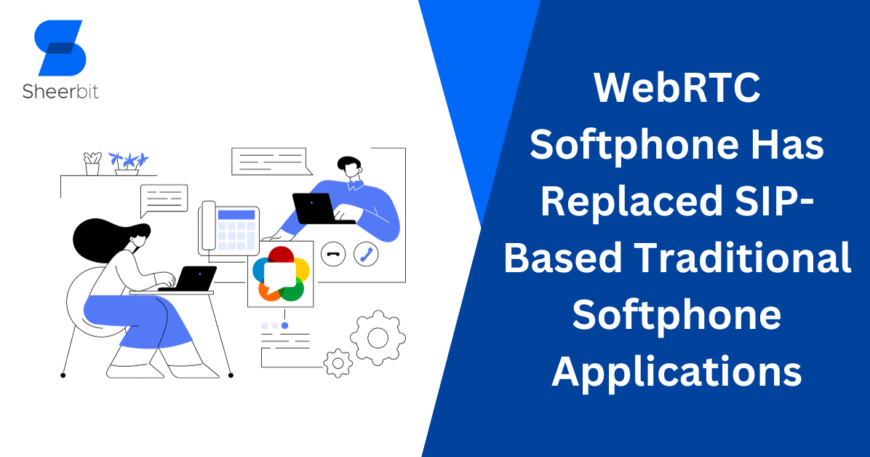Businesses and people continuously seek methods to enhance efficiency, save costs, and simplify communication operations in the fast-changing world of communication technology. For many years, the standard softphone apps that used the SIP (Session Initiation Protocol) protocol were the preferred option. However, a new contender in the market is the WebRTC (Web Real-Time Communication) softphone. We’ll look at the significant changes WebRTC softphones have brought about and how they’ve been supplanted. The more traditional SIP-based softphone apps in this blog article.
Understanding SIP-Based Softphones
SIP-based softphones have become the industry standard for audio and video communication. SIP is a signaling protocol for message, video, phone, and other real-time communication applications. It may also start, maintain, modify, and end sessions. To enable VoIP conversations and promote real-time communication, traditional softphone programs that rely on SIP are frequently employed in contact centers and enterprises.
The limitations of SIP-based softphones include:
- Complex Setup: Configuring a SIP-based softphone usually entails setting up several variables, such as codecs, login credentials, and server information.
- Firewall and NAT Traversal: Call connection problems arise from SIP communication, frequently encountering difficulties navigating firewalls and Network Address Translation (NAT) devices.
- Proprietary Solutions: Vendor lock-in occurs because many SIP-based softphone apps are proprietary and might not be compatible with other systems.
The Rise of WebRTC Softphones
Using straightforward APIs and HTML5, WebRTC is an open-source project that facilitates direct real-time communication between web browsers and mobile apps. Its primary benefit is that it is plain and simple to use, which is why many developers and companies use it.
Here are the key advantages of WebRTC softphones:
- Browser-Based: Web browsers, widely available on most devices, are used to operate WebRTC softphones. Users will no longer need to download and install an additional program.
- Cross-Platform Compatibility: WebRTC is engineered to function flawlessly across various operating systems and gadgets, such as Windows, macOS, iOS, Android, and Linux. Users may converse without encountering compatibility problems because of this cross-platform compatibility.
- No Plugins or Extensions: WebRTC is a great option for anyone looking for a hassle-free communication method because it does not require plugins or browser extensions.
- Secure Communication: Encryption protocols are used by WebRTC softphones to provide private and secure communication. For companies handling sensitive data and having to adhere to regulations, this is essential.
- Simplified Configuration: Configuring a SIP-based softphone is far more complicated than setting up a WebRTC softphone. By only clicking on a button or link, users may place calls, which lowers technological obstacles.
Key Features of WebRTC Softphones
WebRTC softphones have several qualities that make them an appealing option for contemporary communication requirements:
- Audio and Video Calling: WebRTC softphones facilitate virtual meetings and in-person chats by supporting high-quality audio and video calling.
- Screen Sharing: Screen sharing is a simple way for users to help with training, support, and collaboration.
- Instant Messaging: Real-time text messaging is a common feature of WebRTC softphones, enabling users to send messages during conversations.
- Call Recording: Countless WebRTC softphone solutions come with call recording features, which are essential for companies to maintain documentation and guarantee excellence.
- Integration Capabilities: Integrating WebRTC with online applications like as CRM systems and collaborative tools may enhance productivity and expedite workflows.
- Real-World Examples of WebRTC Softphone Adoption
- Customer Support and Service: WebRTC softphones are used by companies that depend on customer care and support to provide smooth customer communication. To offer help in real-time, this includes functions like screen sharing and video calling.
- Telemedicine: In telemedicine, WebRTC softphones provide video chats with patients, share medical records, and enable distant consultations.
- E-Learning: Educational institutions and online learning platforms employ WebRTC softphones to offer interactive online classrooms, one-on-one tutoring, and collaborative learning.
- Remote Work: The rise in remote work has led to an increase in the usage of WebRTC softphones for team collaboration, virtual meetings, and real-time project discussions.
The Future of Softphone Applications
In the upcoming years, we may expect the following innovations as WebRTC continues to gain pace and replace conventional SIP-based softphone applications:
- Improved Performance: WebRTC softphones will probably keep becoming better in terms of dependability, latency, and audio and video quality.
- Enhanced Security: Security will always come first, and aspects of encryption and privacy will be reinforced.
- Wider Integration: More applications and services will make use of WebRTC to provide seamless and integrated communication for users.
- IoT Integration: WebRTC softphones will evolve due to the Internet of Things (IoT). Making it possible for intelligent gadgets to interact with consumers more successfully.
Conclusion
With the advent of WebRTC softphones, SIP-based softphone apps are becoming less and less relevant in real-time communication. WebRTC softphones are becoming the go-to option for people and organizations. Because of WebRTC softphone’s feature-rich feature set, cross-platform interoperability, and easy-to-use interface. To maintain its influence on how we interact in our digitally linked society, we may anticipate more developments in WebRTC technology in the future.





